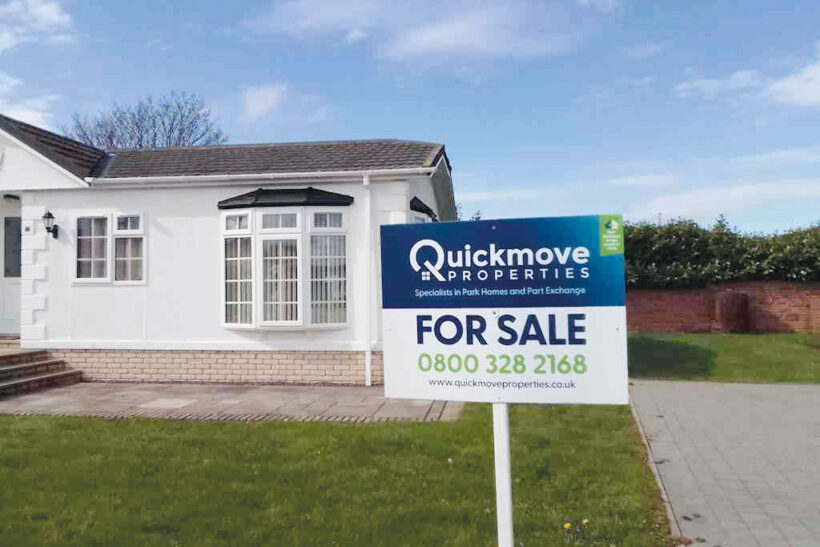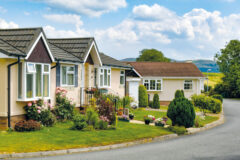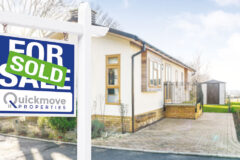We report on the hefty house price premiums facing dog owners in search of green space and how the purchase of a park home could help…
The latest research by over-50s property specialist, Quickmove Properties, shows that dog owning house buyers who want to live in areas of abundant green space in which to walk their four-legged friends are facing house price premiums as high as 94 per cent. And unless they’re willing to move to Yorkshire, they would be wise to look beyond the traditional bricks-and-mortar house in order to enjoy England’s greenest areas.
Quickmove Properties has analysed land use data from the UK Government, looking at the areas of the nation that present the best option for walking our four-legged friends with the greatest abundance of green space such as forestry and woodland, natural land, rough grassland, and outdoor recreation space. Quickmove then analysed this land use data in line with current house price data from the Land Registry to reveal how much more it will cost you to purchase a home in a pooch-friendly green area.
Green space
The analysis reveals that of England’s 13 billion hectares, 2.7 million hectares are classified as green space. For a nation of dog lovers, this means that there is no shortage of great spots for ‘walkies’, with green space accounting for more than a fifth (21 per cent) of England’s land.
Dog owners will be keen to learn that the greenest region of all is the north-east where 39.8 per cent of all land is green. This is followed by the north-west (34.2 per cent), Yorkshire and Humber (25.7 per cent), the south-east (22 per cent) and, perhaps surprisingly, London (20 per cent).
However, those looking to purchase a property within one of the nation’s top 50 greenest areas may well find they are facing a hefty property price premium
for the pleasure.
Fifty greenest areas
Across the nation’s 50 greenest areas, an average of 39.2 per cent of land is classed as green space, while the average house price sits at £338,357 – 11.98 per cent above the national average of £302,164.
Of course, in some areas this premium is considerably higher and nowhere more so than in Elmbridge, in Surrey.
While the area boasts an abundance of green space, with 26.4 per cent of land classed as such, the average house price is a hefty £730,175 – 93.6 per cent higher than the wider average for the south-east region.
Mole Valley, also in Surrey, is some 62.9 per cent more expensive than the wider average for the south-east, while 32.4 per cent of land usage is green space.
In Richmond, in London, 44.7 per cent of the borough is classed as green space, and the average home commands 49.1 per cent more than the wider London house price.
In fact, 31 of the top 50 greenest areas analysed by Quickmove Properties are home to a house price premium when compared to the wider regions in which they are located.
Property market affordability
For those in search of both green space and property price affordability, the best bet is to look to Burnley. Here, 43.9 per cent of the land is classed as green space, while the average house price comes in some 50.1% more affordable than the wider north-west average.
Other areas offering some of the most affordable house prices with an abundance of green space include Pendle (36.9% lower) and Blackburn-with-Darwen (33.6% lower), both in Lancashire.
Sales director at Quickmove Properties, Mark O’Dwyer, commented: ‘For dog lovers, the close proximity of somewhere suitable to take their four-legged friends for a healthy walk is as important as any other property feature. Of course, purchasing within a particularly green and pleasant part of our land is always likely to command a house price premium.
‘As our analysis shows, the house price premiums found across the 50 greenest areas of the nation can be substantial to say the least, although there are some areas where you can buy for below the regional average and still benefit from an abundance of green space.
‘The only downside is that the majority of these more affordable areas are limited mainly to Yorkshire and the north-west. Great news for those in the area, but not so great for those who don’t plan to relocate to the other end of the country.
‘For those looking to make their move in later life, a park home in a rural or coastal park community is an increasingly popular option. It can release valuable equity built up in your home while providing an affordable alternative when purchasing in an area with plenty of great dog walking options.
‘Most residential park home communities are dog-friendly and located in some of the best areas of the nation for outdoor pursuits such as walking. Your furry best friend may be spoiled for choice and likely to find plenty of pedigree pals when moving to the close-knit community of a park home site.’



